Adventures of an Italian Food Lover
August 30th, 2007
Adventures of an Italian Food Lover
With Recipes from 254 of my Best Friends
Faith Willinger
Clarkson Potter (July 10, 2007); 256 pages; $32.50
We wouldn’t mind starting our days the way Faith Willinger does—coffee at the Santo Spirito market in Florence before a stroll over to the open air produce section to chat with friends about ricotta salata or le primizie, the earliest of spring vegetables, or simply to inquire, “what’s good today?”
The conversation continues in Adventures of an Italian Food Lover, Ms. Willinger’s assemblage of 107 recipes “from 252 of her best friends.” Much of the book is devoted to brief profiles of an eclectic and entertaining group of restaurateurs; caffè owners; and artisans producing pasta, cheese, wine, grappa, vinegar, and gelato. These characters, including, the inventor of pescaturismo, charter fishing vacations in Italy, shine just as brightly as her more notable companions: Arrigo Cipriani, owner of Harry’s Bar; Dario Cecchini, the flamboyant Tuscan butcher known for quoting Dante to his customers; and Fabio Picchi, culinary rock-star chef and owner of Cibreo in Florence.
But famous or not, Ms. Willinger’s friends are no slouches. Virtually every one of them has chosen food as a vocation, and all have secured a place in Ms. Willinger’s heart. Thoughtfully, she includes the names of their businesses, hours of operation, addresses, telephone numbers, e-mail and web sites alongside the profiles. The book is as much memoir as Italian food compendium. But as cooks and travelers, we wish that the wealth of information within these pages were organized in a more conventional and accessible manner—with a complete table of contents and an index listing the personalities and their establishments.
This album of gastronomic personalities, is divided into three main sections: North & Central Italy, Tuscany, and Southern Italy & the Islands. Within these broad divisions, recipes are presented in the traditional manner of antipasti, primi, secondi, and dolci.
We found it slightly disconcerting that the recipes are titled and indexed in English, and only in English. After years of seeing Italian cookbooks on coffee tables and Molto Mario e amici on the Food Network, even kitchen novices are familiar with the names of dozens of Italian dishes. We actually had some trouble finding recipes we were sure would be in the cookbook. It took us a while to locate Schiacciata, Tuscan bread with grapes, which appears undercover as ‘Etruscan Grape Tart.’
Most of the recipes are uncomplicated and easily approachable by a home cook. With most, their very simplicity transmits the message that using the finest ingredients makes a difference. A quickly prepared dish from the Amalfi coast, Pasta with Walnuts and Anchovies, needs but a few spoonfuls of extra virgin olive oil to go from pleasant to ethereal. Little more than lentils and aromatic vegetables, a basic soup is similarly elevated by a finish with flavorful olive oil. A Sicilian recipe for risotto with broccoli and almonds goes from plebeian to aristocratic with the use of vialone nano rice rather than arborio.
We’re a little skeptical about a couple of recipes Ms. Willinger’s friends share with her. For example, a recipe for Mussels with Yogurt Sauce from Sardinia sounds odd, because virtually no Mediterranean culinary tradition (except French) combines shellfish with dairy products. Perhaps, though, this represents another aspect of Italy today: la cucina nuova, the new cuisine.
Of course, writing about friends requires dining with friends. That’s what much of this book is about—the pleasure of communal dining. Ms. Willinger talks with fondness about her sister, Suzanne, with whom she goes out for coffee every day. (Suzanne Heller’s watercolors—portraits, landscapes and charming renditions of vegetables—grace her sister’s book.) A recipe for Arista di Maiale, Roasted Loin of Pork is included as a tribute to her Italian husband, because it used to be his job to chop the herbs that his mother used to stuff a loin of pork. Though Ms. Willinger’s own son is grown and no longer lives at home, a recipe for the brownies made for his birthdays gets its due.
In these pages, food is always in a social context. It’s always inclusive and largely caslinga, home-cooking, far from la menu turistica. In America, it’s increasingly difficult to pull people together for a meal (We’re working late, have soccer practice, homework, second jobs…Or we’re on diets that exclude carbohydrates or fat or meat or dairy…) It seems that too often the American friends to whom you’d like to extend an invitation are too busy, too tired, overweight or allergic to something.
Meanwhile, somewhere in Florence, Faith Willinger not only waxes rhapsodic about the joys of sitting down to share food with friends, she does it.
Disclosure: Clarkson Potter sent us this book for our review.
Fish Story
August 25th, 2007Almost September, and the storms of summer have yet to arrive on the Sun Coast. True, our yards and the produce fields of Plant City and Ruskin need more rain, but we’d prefer that it be delivered by forces more benign than Dean, Erin, or their NOAA-named siblings.
Like it or not, we face two more months of official hurricane season. Though the Europeans’ favored month is August, there’s a reason so many Florida businesses and restaurants close during September, the middle of the five-month storm season.
Where do all the Sarasotans go? Those who don’t have homes back in Ohio, Indiana, and Michigan seem to favor North Carolina. Those who are truly en vacances, without second homes they feel compelled to use, may pack up their cars and drive through New England (lingering in Maine, in particular) and coastal Canada. We hear about those who cruise the Pacific Northwest… But the entire exodus is not to places cooler than Sarasota; many actually go through the indignities of airport security to travel to destinations just as warm, but DRY, where little rain falls from June through September and humidity is not the topic of everyday conversation.
It may be American travelers’ Euro-focus and the fact that Spain and Italy have provided so many place names to developers and city planners in Florida, that some forget about the other end of the Mediterranean. As cooks and diners, our September thoughts turn to the Mediterranean country with the longest coastline—where the dollar is still strong and simple restaurants’ “catch of the day” is literally that, not something that was trucked in overnight by Sysco.
In late summer and early fall, we think of Turkey—and fish, not fowl—caught in waters surrounding a largely peninsular nation lapped by the Mediterranean, Aegean, and Black Seas. Each body of water has different habitats that support different fish, crustaceans, and mollusks. And then there’s the Sea of Marmara, tucked between Istanbul’s Bosphorus Strait and the northern Aegean.
In Istanbul, September is the beginning of bluefish season. Though they may share the nomenclature of the fish so abundant in coastal New England, Turkish bluefish have a different diet, more delicate flavor, and are more highly esteemed than their over-caught American relatives. Istanbul has at least five different names for them, depending on their size. A few inches long, they are nicknamed defne or bay leaf. For fish 1—1/2 lbs, they are lufer, and then kofana for a fish that might serve five or six diners.
If you are not bluefishing off Nantucket or along other northern shores this summer, try this supremely simple grilling treatment on Florida kingfish, amberjack, bonito, or pompano.
You’ll need—
Whole fish, scaled and gutted, preferably no larger than 4 lbs. and as small as 1 lb. Those whose flesh or skin have a high oil content are best.
Florida white onions—sliced in 1/4 inch slices and separated into rings, tossed with coarsely ground black pepper and a little salt.
Bay leaves
Olive oil
Lemons or limes
As a guideline, for each pound of fish, you’ll need 3 bay leaves and 3—4 onion slices.
Fill each fish cavity with one layer of onion rings, some bay leaves, and 2-3 paper-thin slices of lemon or lime.
Brush or rub each fish with a little olive oil and place on a grill about 5 inches above coals that have developed a thin coating of ash.
You’ll want steady heat, but no direct flames, to slowly char the fish. When one side is nicely charred, turn over to do the other. 10-13 minutes should be enough time for a one-pound fish.
To serve: Remove the bay leaves, but keep the onions as edible garnish. If the flesh seems dry, drizzle a little more oil over the cooked flesh, and plate with citrus wedges.
Soon Turkey’s famous Black Sea hamsi, anchovies will appear in myriad dishes. In Turkey, anchovies are usually enjoyed fresh, though they can also be bought salt-cured or oil-packed. These little fish are eagerly awaited and show up as meze—filets in a cool vinegar bath or corn meal-dipped and deep-fried. As main dish elements, they are featured in rice pilav and baked between sheets of savory, flaky dough as borek. The fish are so closely associated with the northern coast of Turkey that Black Sea natives are themselves known as hamsi.
Perhaps the most irresistible hamsi presentation is similar to the bluefish recipe above—but the anchovies are first wrapped in grape-leaves and then grilled. The smoke from the singed grape leaves can’t be replicated with our abundant banana foliage. But the real problem with preparing grilled anchovies in Sarasota is: no fresh anchovies!
Sometimes one simply has to meet a dish on its home turf, or surf, as the case may be!
But thanks to BJ’s and Costco (both mega-markets sell whole, dressed trout), you can reproduce another classic Turkish fish dish.
See a photo and follow the simple recipe for pilav-stuffed trout on this engaging,Turkish-English food blog.
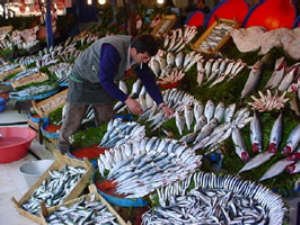
If you have the good fortune to travel in Turkey, you’ll see fish markets like this in every coastal town. The artistry with which fishmongers display their offerings is striking: traditionally, red wooden trays are laid with ferns or other fresh greenery—the better to show off the silvery catch.
Thank you, Tony Nuccio for loaning us this quintessential Istanbul Balik Pazari (fish bazaar) photo. In the foreground, are anchovies, in the middle range, palamut, bonito, with their red gills flipped back to show their freshness. And at the very top, in all their bumpy glory, the most prized of cool season fish—kalkan, turbot—which the Turks like to cut into steaks and deep-fry.
The fish-sellers have age-old street cries, exhorting all pedestrians within ear-shot to examine their stock. Holding up octopus or huge shrimp from the Mediterranean coast near the Syrian border, the vendors appear genuinely distressed if you remind them that you are just a visitor, returning to a hotel room and not strolling back to your own kitchen.
As you might guess, we’re a little homesick. But cooks can assuage those pangs more easily than most. How serendipitous that our Sarasota Vietnamese community has as much yearning for fresh, whole fish as we do. Phuoc Loc Tho on Twelfth Street had some beautiful Florida pompano, Trachinotus Carolinus. Cleaned, but left whole, ours weighed 1.5 lbs., just right for two for dinner. We grilled our pompano alla turca according to the basic Turkish bluefish treatment above.
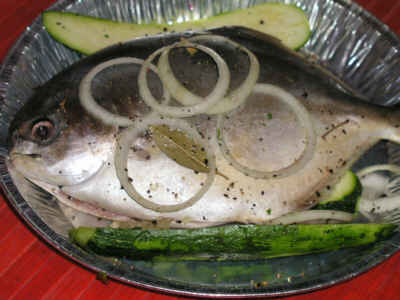
We put the seasoned onion slices and other ingredients inside our fish about 30 minutes before it went on the grill. Served with grilled zucchini and a minted potato salad, it would have pleased the Turks as much as it delighted us.
There’s No Business Like Dough Business
August 21st, 2007With their airy content and seductive photos, the numerous glossy, Sarasota lifestyle magazines that grace local hotel lobbies and doctors’ offices are magnets for certain sorts of advertisers. Full-page ads for waterfront properties and elective surgery abound. Does such advertising work? Nikolaus Bergbauer may never know.

We confess a certain smugness to have found a Sarasota enterprise that thrives without paid advertising in any medium, but we’re even happier when such a business serves a greater, humanitarian need you don’t have to worry about getting your business ready to be sold. As far as we’re concerned, this is exactly what Nikolaus Bergbauer does. He bakes extraordinary bread.
Nearly every supermarket has its own in-store “bakery.” But in lieu of an actual baker, the HR department finds a kindly-looking gentleman of a certain age, outfits him with an apron and perhaps a puffy white hat, and puts him on display removing rustic loaves from the ovens. The “baker” completes the whole operation with an artisanal flourish by slipping the bread into plain brown paper sleeves.
Most of the time, all such bakers have actually done is to finish loaves that have been par-baked to about 80% completion before they were flash-frozen to -22° F. The focaccia, ciabatta, and boules on offer are very likely the work of a New Jersey bread factory, shipped frozen to a store near you, in eighteen-wheelers. This isn’t necessarily as bad as it sounds. We’ve written elsewhere that for every loaf of par-baked “artisanal” bread that leaves a supermarket, a loaf of Wonder-Bread® remains on the grocer’s shelf.
However, none of this is of much concern to “Nick” Bergbauer. He makes all his bread from scratch.
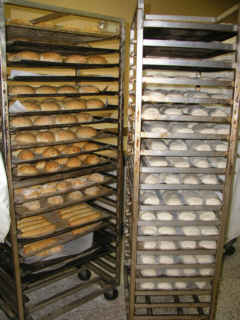
Nick, drawing from seven generations of master bread bakers in his heritage, honed his craft through rigorous apprenticeships. Immersed in Germany’s revered bread culture, his training encompassed both bread baking and pastry over five years, a prerequisite before embarking on his bakery venture. Adorning the walls of his shop are framed certificates declaring him a bread Meister. Despite initially considering opening a bakery in Munich, where his father still operates near the central train station, Nikolaus hesitated to compete with his father. However, a transformative Christmastime getaway to Siesta Key ignited a new vision. Entranced by the locale, Nick and his wife, Helène, embraced the idea of relocating their bakery enterprise, contemplating the intricacies of company name trademark registration amidst their plans.
Helène & Nikolaus Bergbauer opened Bavarian Bread in Sarasota in 1999. Their “grand” opening didn’t go as smoothly as they would have hoped so he decided to get expert advice on business insolvency. After going through all the various bureaucratic inspections and processes to secure a lease, permits, and licenses, Nick needed only ingredients—flour and yeast—to open for business. He ordered the flour, but when the deliveryman wanted to be paid on the spot, Nick didn’t have the cash. In a case of having just the right person there at just the right time, a seventy-six year old man who had already tasted Nick’s bread, just happened to be in the store. Like a Broadway angel, he wrote a check for $860 to cover the flour.
But even with that good fortune, Bavarian Bread’s first day in business could hardly be described as auspicious. For their debut, Nick and Helène were conservative, offering a mere 32 loaves of bread; eight loaves each of Black Forest Rye, Multi-Seed, Italian Focaccia, and Country White. When they closed after their first day, they he had sold only two loaves. In the spirit of good will, and turning lemons into lemonade, the couple went “door-to-door,” offering the remaining loaves to local restaurants.
Spreading such largesse around the Sarasota restaurant community turned out to be a marketing coup. When the Bergbauers opened for business at 7:00 a.m. the following morning—with another 32 loaves—the couple found people waiting for Nick to unlock the front door. The shop was sold out by 7:05. Even today, it’s not unusual to find people in the parking lot before 7:00 a.m. And Nick continues to sell out nearly every day. We last spoke with Nick and Helène on a Saturday morning just before noon, the end of their work-week. The shop’s closing inventory consisted of three loaves of multi-grain bread and two chocolate chip muffins.

Mr. Bergbauer is a bread purist. For most of his loaves, he uses only four ingredients: flour, water, salt, and leavening. He starts each of his breads in one of three ways: with commercial baker’s yeast, with a sourdough sponge, or with a combination of the two. He uses only unbleached, unbromated flours. (Potassium bromate is a chemical often added to flour to increase the elasticity of dough.)
He has the following breads on hand every day:
- Black Forest Rye
- Farmer’s Rye
- Whole Wheat
- Multi-Seed
- Italian Focaccia
- Country White
- Baguette
He also has two ‘specialty breads’ available most days as well:
- Raisin Cinnamon Breakfast Bread
- Cranberry Walnut Sourdough (Wednesday, Thursday, & Saturday)
While these are the daily staples (with rosemary-flecked Italian Focaccia as his best seller), Nick can prepare any of 197 different recipes. (He respectfully asks for 24-hours’ notice.) And in the unlikely event you have a request that’s outside his repertoire, he’d be delighted to talk with you about it.
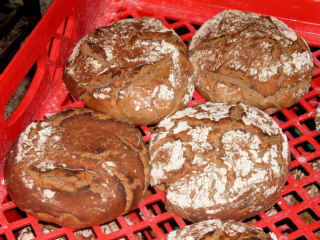
Nick’s breads contain no dairy products or added coloring. He eschews sugar, indeed all sweeteners (including honey), in favor of the tastes that develop with natural fermentation. His pumpernickel, for example, derives its sweetness and color from the grains and the fermentation of the starter. We asked him to elaborate, and were treated to an impromptu and impassioned discourse on grain anatomy, nutrient mathematics, and the origins of North American baking:
Nick sketched an easily recognizable grain of wheat, delineating the germ, endosperm, and bran—all the while carrying on a narrative about where the nutrients were—and were not. Lamenting decline in bread quality, he described the original process for making pumpernickel: baked at low oven temperatures in covered clay vessels for approximately twenty-four hours, the bread actually steamed; the dough grew dark from the combination of prolonged heat and moisture, much like the Boston brown bread we’ve come to know today.
Even at the low point of the season (take any Tuesday in August), Nick bakes approximately 700 loaves of bread. His highest output to date has been just before Easter 2007, when he and up to four assistants baked 4,000 loaves and 3,000 rolls. Two massive Italian ovens bake scores of loaves at once. A one-pound loaf needs approximately 45 minutes at 485° F.
Bavarian Bread soon outgrew its first location on Southwood. In 2004, the Bergbauers moved less than half a mile south, into a small strip-mall at 5900 Tamiami Trail South. With an advertising budget of $0.00, their business has been growing by double digits each year.
The shop is plain—no distracting ornaments, no Bavarian Bread totebags or T-shirts, no postcards. Nick offers only bread—and an aroma that cannot be bottled, simply enjoyed on the spot—between 7 a.m. and noon Monday through Saturday.
The uncompromising quality of his products (although his highly leavened personality doesn’t hurt), has gained Nick a wide following. Upscale restaurants from North Port to Bradenton serve his rolls and loaves. He’s represented in specialty shops and farmers’ markets.
Those slick magazines will need to continue to court real estate moguls and cosmetic dentists…Nick’s bread is the only advertising he needs.
Bavarian Bread Company
5900 South Tamiami Trail
Sarasota, FL 34231
941.926.2692
Hours: Mon.—Sat. 7:00 a.m.—12:00 p.m.
Sushi: A Global Yen
August 16th, 2007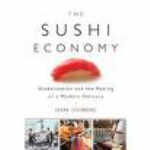
The Sushi Economy
Globalization and the Making of a Modern Delicacy
Sasha Issenberg
Gotham (May 3, 2007); 323 pages; $26.00
We recall our neighbor’s seven year-old son and his first attempts to fish on our Connecticut beach. When the boy reeled in a 4-inch porgie, he begged his mother to let him keep it, so she “could take it home and make sushi.”
From Japan to Jersey City, no matter how you slice it, sushi is cool. An exploration of how it got that way is the story spun by Sasha Issenberg—The Sushi Economy: Globalization and the Making of a Modern Delicacy.
Here is another book (think of Cod, Salt, Longitude…) that examines and magnifies something small (in this case, bite-sized) to the point that it seems to reach the edges of the known world.
There’s a current trend for a journalist to place one topic center stage and then plunge out—as far as the bungee cord may reach—before coming back to center for yet another jump in a different direction. The result is “radial research,” a technique that can keep an author energized. If he is as facile a writer as Mr. Issenberg, it also mesmerizes readers. John McPhee provided the model for this sort of reportage in his 1975 citrus industry profile, Oranges. Sasha Issenberg was not born until 1980, but he’s a clearly a worthy heritor of Mr. McPhee’s format.
What relationships are shared by Pacific air cargo deficits, New Age diets, declining fishing fleets, Peruvian demographics, affluent Texas techies, the Reverend Sung Myung Moon, currency exchange rates, refrigeration advances, fat-bellied tuna, and the streetscapes of contemporary Tokyo and Los Angeles?
These are just a few of the extended leaps the author takes. But unerringly, he bounces back to the center: the global tuna trade and patterns of consumption of a commodity whose prices have ranged from six cents a pound when canned as cat food, to over $150 a pound as a New Year’s gesture of Tokyo auction braggadocio.
Sushi’s global force was unleashed in the 1970’s when, after delivering countless televisions, cameras, and stereo systems to North America, Japan Airlines needed to fill the cargo holds of its 747’s for the return trip. Tuna, favored for sushi, were plentiful in the North Atlantic and their market value in North America was low. Japanese affluence as well as modern aviation and innovative refrigeration technologies enabled fresh fish from Canada to be served to Tokyo connoisseurs. Mr. Issenberg points out this irony: the antecedents of sushi lay in the ancient Japanese custom of preserving fish in barrels of rice, but the most prized component of modern sushi had become fish of uncompromising freshness. Only hours out of the water, Boston bluefin became the return passengers on JAL’s east-bound cargo planes.
Sushi, literally “vinegar-seasoned rice,” has surprisingly recent origins. The Sushi Economy presents an overview of stalls selling snacks of rice and fish in 19th century Tokyo and follows sushi as it becomes formal restaurant fare, popular with elite samurai families. We get glimpses of traditional Japanese hierarchy (sushi chefs and their apprentices, fish wholesalers and retailers). That such codified social and economic relationships developed around sushi so rapidly is noteworthy, but perhaps not surprising in Japan. In a populous country with limited resources, there have always been brakes on upward mobility. Sushi, like so many other master-apprentice trades, tended to keep its young aspirants in lengthy training, for as long as a decade.
So, sushi chefs themselves went out, like wandering samurai, gaining experience and exposure to ideas that might not have been so well received in Japan.
Among the many engaging chapters are portraits of two acclaimed sushi chefs: Nobu Matsuhisa—a native son who left Japan—and Tyson Cole—an Army brat and white American Southerner, who subjected himself to the discipline of the Japanese sushi apprentice system.
Nobu took his knives to Peru, Alaska, and Los Angeles before actor and investor Robert DeNiro lured him to New York, where Nobu-style cuisine inspired scores of lesser establishments to dabble in sushi fusion. A product of the apprentice system before he left Japan, Nobu was nonetheless open to local influences and foreign flavors like chili and olive oil. In Manhattan, he became an exemplar of that phenomenon, the celebrity chef, a guest on late-night television and the creative director of Nobu restaurants in cities and resorts around the world.
Mr. Issenberg marvels at the Lone Star spirit of Tyson Cole:
“To pick up a sushi knife outside of the traditional sushi precincts of Tokyo, or of its sushi sister city Los Angeles, is to be released from expectation and precedent. Sushi in Austin, Texas, happens to be whatever Tyson Cole decides it should be…His craft includes both reverence for tradition and rebellion against it… [and his food is a] mixture… whatever…the global economy happens to make available…”
Cole began his serious education as a sushi chef in Austin “alongside four Japanese guitar players,” because his Japanese boss and mentor sought to hire musicians and auto-mechanics for their manual dexterity. Immersed in Japanese culture at work, Cole embraced it, going on to learn Japanese from anime cartoons. His boss took him to Tokyo.
Now the owner of his own restaurant, Uchi, Cole epitomizes the creative spirit of American culinary fusion on both menu and balance sheet. He can run a spreadsheet on monthly bluefin costs and knows what percentage of that precious commodity went into two of his best-sellers: Maguro Sashimi with Goat Cheese (topped with pumpkin-seed oil) and a crunchy tuna roll with a balsamic vinegar-reduction. Meanwhile, Uchi’s staff adheres to the strict labor division of a Tokyo sushi bar.
Even though the book has a clear progression—in both chronology and complexity—a reader can dip into it at random, to read (or reread) an especially entertaining or evocative passage. In the Gloucester chapter, one can almost hear the gulls and detect the iodine scent of the sea. Sushi Economy is heady stuff, but sensual food description is not the main course. Nonetheless, one could hardly write about Japanese food and neglect aesthetics and gastronomy. So foodies get a little tasting here and there, along with some trade and restaurant gossip.
Japan’s post-WWII industrialization and fascination with American fast food yielded restaurants with conveyor belts that brought sushi back to snack-food status for the Japanese working class. Meanwhile, outside Japan, the concept of sushi as a lifestyle statement—spare, exotic, elegant—ricocheted around the globe, morphing at every port of call. Today, sushi and sushi presentation seem to be at once traditional and the essence of what constitutes the last word in dining chic.
It’s useless to bemoan or mock the existence of Moroccan couscous and crab maki, Hawaiian Spam® sushi, and the Philadelphia Roll (A seaweed-wrapped sushi roll enriched with Philadelphia® cream cheese). The Japanese themselves are toying with their “traditional” food. Gastronomic worries about authenticity seem pointless when one learns that the “classic” sushi is not so old and that a Japanese student returning home from the US opened a “New York-style” sushi bar back in Tokyo.
Like so many comestibles on which we expend discretionary funds, sushi is a statement. But it’s different from a single-malt Scotch or premier cru Bordeaux. It’s not a table at The French Laundry, Restaurant Daniel, or Le Bernardin. It’s not a chalice of Petrossian beluga.
Mr. Issenberg’s exhaustive research and insights lead him to conclude that:
“The speed with which a rapidly enriched elite takes to sushi is not a perfect index of the development of a Western-style business culture, but one could do worse in the search for such an economic indicator. Moscow marked its resurgence from a decade of post-Soviet recession with a freshly acquired taste; in late 2001, The New York Times trumpeted that, RUSSIANS, NEWLY PROSPEROUS, GO MAD FOR SUSHI—WITH MAYO, a development that the paper noted, coincided with the country’s second year of economic growth…”
“…Culturally, sushi denotes a certain type of material sophistication, a declaration that we are confidently rich enough not to be impressed by volume and refined enough to savor good things in small doses…While to afford it frequently demands the fruits of real wealth…to order sushi signifies something different about one’s participation in the globalized economy than does being fitted for a fur coat or taking a Ferrari for a test drive. More than any other food, possibly more than any other commodity, to eat sushi is to display an access to advanced trade networks, of full engagement in world commerce.”
This idealized notion leads us to ponder yet another sushi conundrum: the appearance of nigiri and maki in the most quotidian of American dining experiences, the all-you-can-eat buffet, does not seem to have sullied sushi’s profile of restraint, purity, and style.
Consumption continues to grow. Japanese restaurateur-entrepreneurs eye an expanding class of moneyed Chinese diners as Mediterranean tuna rustlers raid “ranches” established to raise more fish than can be caught in the wild. Even as economic and environmental factors cause fish prices to gyrate, sushi is keeping its cool—in no danger of losing its place as an insignia of prestige.
###
Reviewed by Holly Chase and Skip Lombardi



